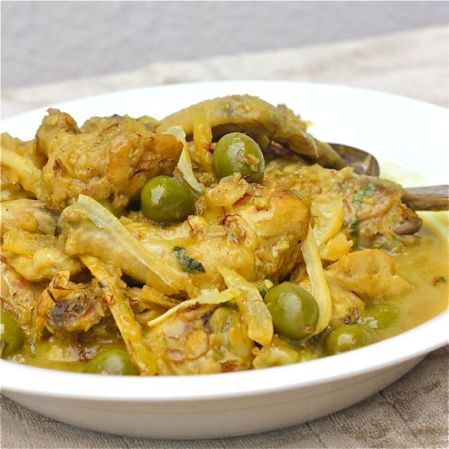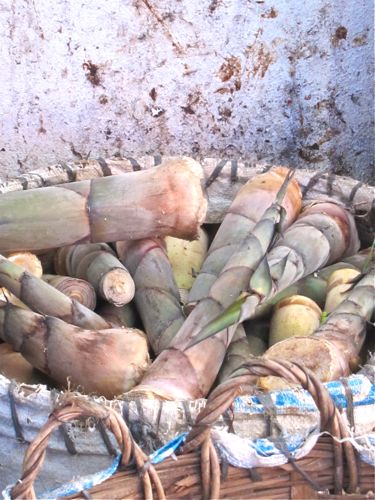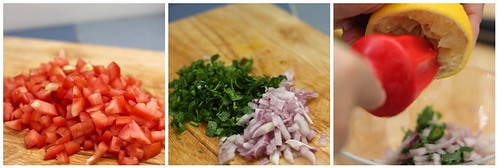Hi Everyone, I have moved to http://www.hungryc.com. Please click on the link to read my latest posting.
New Address
July 18, 2010Chicken With Preserved Lemons and Olives
July 5, 2010
I was in New York last month for the screening of Sex and The City 2. Hewlett-Packard (HP) hosted journalists from around the world for the screening; they collaborated with Warner Bros on the chick-flick which is in line with their strategy of focusing on their women clientele. Journalists were introduced to HP’s stylish netbooks, which were designed by Vivienne Tam and the latest is their ‘Butterfly Lovers’ series.
Everyone was of course more excited about the movie screening at the Paris Theatre, only a day after its premiere in New York. No, we didn’t meet the SATC cast as they were all in Tokyo, Japan for the Asian premiere.
Still, HP hosted us in style – chauffeuring us to the screening from our hotel in Time Square in a stretch limo. By now, everyone would have seen the movie, so I’ll not go into that – let’s just say that I am more a fan of SATC the tv show than the movies. Still, I am in New York… and two and a half hours of watching beautiful people in beautiful clothes is no hardship.
After the movie screening, there was an after party at the Bergdorf Goodman store. The window dressing all had SATC themes, and they were gorgeous. There were loads of fashionable and beautiful people at the party. Willie Garson (Standford Blatch) and Mario Cantone (Anthony Marantino) were there – they had the best scenes in the movie; the gay wedding scene was the blast. Malaysian supermodel Ling Tan was there. Ivanka Trump was sitting a few rows in front of us, but she didn’t stay for the party.
I was starving by the end of the movie, and was looking forward to the party (for the food….of course). And I was pleasantly surprised to find the Middle Eastern buffet – because of the Abu Dhabi getaway, I guess. There were lamb kebab with yoghurt sauce, couscous, lamb stew with olives, red pepper salad, bread and hummus. I ate my share, but didn’t eat all that much. It was a little hard to eat as there were loads of people milling about.
My New York trip wasn’t an eating trip. I walked a lot, and only stopped to eat whenever I was hungry. And as I was on my own, I didn’t eat in restaurant but only grabbed pizzas and nachos and burritos.
Anyway, I have been craving Middle Eastern food on and off since that party. In New York I was drawn more to the falafel and kebab stalls than I was to the hot dog stands; I just never got around to eating from the stalls because the hawkers were either not ready yet or I was too stuffed from another meal or rushing somewhere.
And at the Whole Foods Market at Columbus Circus, I love the selection of olives – a tub of gorgeous mixed olives and they cost less than they do in Malaysia. I thought of lamb stew with olives, but mostly I just wanted to snack on them.
So, when we were doing the column for StarTwo this month with the theme of preserving food, I immediately thought of making preserved lemons. And when it comes to Middle Eastern food, my most trusted cookbook author is Claudia Roden.
PRESERVED LEMONS
(Adapted from Claudia Roden’s recipe in
Arabesque)
Recipe
4 lemons
4 tbsp salt
Lemon juice
Wash and scrub the lemons. Quarter the lemons right to the end of the stem, but not right through.
Stuff each lemon with a tablespoon of salt.
Put the lemons in a sterilised jar, pressing them down as much as possible. Close the jar, and leave for 3-4 days. In that
time, the lemons would have disgorged some of their juices and the skins would have softened.
Open the jar, and press down the lemons. Then, add fresh lemon juice to cover the lemons in the jar.
Close the jar and leave in a cool place for at least a month.
To use, discard the pulp and rinse the lemon peel to rid it of the salt.
With the preserved lemons, I made Claudia’s Moroccan Tagine of Chicken with Preserved Lemons and Olives. It’s easy to make, and absolutely delicious – the preserved lemon lends aroma, depth and its distinct flavours. The olives are of course delicious; wash them a few times if you don’t them too salty.
3 tablespoons of extra virgin oil
2 onions, grated or chopped finely
2-3 cloves of garlic, crushed
1/2 teaspoon of crushed saffron threads or powder
1/4-1/2 teaspoon of ground ginger
1 chicken, jointed
salt and black pepper
juice of 1/2 lemon
2 tablespoons of chopped coriander
2 tablespoons of chopped parsley
peel of 1 large or 2 small preserved lemons
12-16 olives
In a wide casserole, heat the oil and put in the onions. Saute, stirring over low heat, until they soften and add the garlic, saffron and ginger.
Put in the chicken pieces, season with salt and pepper, and pour in about 300ml of water. Simmer, covered, turning a few times and adding a little water if it becomes dry. Lift out the breasts after 20 minutes, and set aside. Continue to cook the remaining pieces for another 25 minutes, after which time return the breasts to the casserole.
Stir the lemon juice, coriander, parsley, the preserved lemon peel (cut into strips) and the olives into the sauce. Simmer, uncovered for 5-10 minutes, until the reduced sauce is thick and unctuous.
Roselle Cordial
July 2, 2010There were lots of roselle for sale at the Satok weekend market in Kuching, Sarawak. I haven’t seen these fruits in years, and certainly never thought I’d one day have to buy them. We used to have roselle bushes in our garden, and they grew everywhere in the neighbourhood.
The roselle belongs to the hibiscus family. If there is such a thing as trend in gardening, then there was a time when it was fashionable to plant roselle. They were real pretty too, with their vivid red berries.
The roselle plants grew well, yielding generous harvests….not that I ever tended to the garden then. I only remember that we love roselle because it was like the poor man’s substitute to Ribena (blackcurrant drink). It was sweet, and had a more tangy edge… but it had a pleasant berry-ish taste and it was real refreshing with lots of ice.
We must have made bottles and bottles of cordial from the roselle in our garden. I don’t remember when the roselle bushes disappeared from our garden and the neighbourhood, and I never gave it much thought.
I bought a basket of roselle at Satok because I had a sudden craving for the drink. Besides, a basket only costs RM1. And so I stuffed it in my suitcase, and brought it back to KL.
It’s easy to make roselle cordial. Just peel off the calyx (your fingers will be stained red) and discard the seedpod. Wash and rinse well, and then boil in water with loads of sugar. I had started out taking careful measurements, but lost track of how much sugar I used as I added the sugar twice more while making the cordial. The roselle is sour-ish, so you need a bit more sugar. It’s also nice to make the cordial thick.
My RM1 of roselle yielded a small bottle of cordial, and it’s as good as I remembered it to be – sweet with a pleasing sourish tinge – exactly the drink for hot afternoons.

And the kids like it too, and at least we know that there is no preservatives or artificial colouring in ths cordial ….. just copious amounts of sugar!
Satok Market, Kuching, Sarawak
June 29, 2010The narrow lanes in the Satok weekend market in Kuching, Sarawak (a state in East Malaysia in Borneo) are crowded, and it gets really hot under the colourful canopies. But I’d not miss going to the market, which opens every Saturday and Sunday, as it’s the best place to find Sarawak’s food produce, handicrafts and knick knacks.

The sweetest pineapples are of course found in Sarawak

At the livestock section, you can buy everything from these cute ducklings to puppies to Siamese cats
The market is divided into different sections – wet market, dry market, plants and pets section, clothes and shoes section etc. It’s not that big, so it’s easy enough to meander from lane to lane.
For locals, the weekend market is where they come for ingredients from other parts of Sarawak. There are jungle produce like ferns, bamboo shoots, yam shoots, roselle, herbal roots and honey. There are also dried and preserved food like shrimp paste, cincaluk and smoked fish.

Smoked fish is a local specialty, and not many know how to make this

Fern shoots – delicious simply stir-fried with garlic or with sambal belacan
I love the market because so many of the produce sold are foreign to me. I didn’t buy much because we didn’t have access to a kitchen in Kuching, but I tried what I could there. I bought ikan terubuk asin (which I’ll blog about later), roselle (next blog) and Sarawak laksa paste.

Keranji madu, tamarind fruits which are encased in a hard shell. The thin flesh is sweet, and are hardly found outside of Sarawak.

Sarawak’s version of palm sugar, gula apong

Cincaluk is delicious with a squeeze of lime and chilli padi
Steamed Squid – Thai-style
June 19, 2010I made steamed squid for the first time last week when I tried a recipe from Jo Marion Seow’s Soya & Spice as I was reviewHer recipes are mostly Toechew ones, and the steamed squid with taucheo (preserved and salted yellow beans) and coriander was really good. Best of all, the recipe only calls for three ingredients, and takes all of 5 minutes to make. The star ingredient though was, for me, the coriander. I kept heaping on more coriander as it really perks up the dish.
Eating that entire plate of steamed squid (all on my own) got me hankering for more steamed squid, and more coriander. And it also got me thinking of the steamed squid I had in a Thai restaurant outside Alor Setar, Kedah. There is steamed squid, and coriander, but the dressing is certainly a stark contrast to the salty taucheo. The Thai dressing is sour, sweet and burning hot. I remember wanting more and more of the Thai steamed squid, and drinking loads of iced water to cool my burning lips… what worked best was the jelly in young coconut that we had for dessert.
Anyway, I looked up the recipe and decided to concoct the dressing without the garlic that is called for. I used thinly sliced shallot instead, and kaffir lime leaves because I have the plant in my garden, and I love its fragrance. The important ingredients are the lime juice, sugar, fish sauce and bird’s eye chilli, and getting the balance of flavours that you like best.
And of course I heap on the coriander – lots and lots of it. And after dinner, I made a bowl of tomato salsa and heap on loads and loads of coriander – cos I am obsessive, but just a little obsessive, not crazy stalker obsessive. Tomorrow I’ll move from coriander to something else….
STEAMED SQUID
RECIPE
500g squid, cleaned and deskinned
1 medium lime, juiced
2 shallots, thinly sliced
4-5 bird’e eye chilli, chopped
1 tablespoon sugar
1 teaspoon fish sauce
2 stalks coriander, coarsely chopped
2 kaffir lime leaves, sliced
Steam squid for 4-5 minutes. Remove the steaming liquid, and cut the squid into thick rings.
Make the dressing by mixing the rest of the ingredients together. Taste to check if you like the sweet-sour-hot balance.
Then, pour over the squid.
You might also like
Dumpling Festival
June 15, 2010It’s the fifth day of the fifth Lunar month this Wednesday; the day that we celebrate the Dumpling Festival. There is a story of how it’s to remember the day that villagers threw in dumplings into the river so that the fishes won’t eat this famous poet who was wrongly punished. The poet is unknown to me; all I know is that it’s the reason we have delicious dumplings every year.
There are many versions of dumplings, although it’s essentially made of rice. The one we have at home is made of glutinous rice, with belly pork, salted egg yolk, mushrooms, chestnut, and dried prawns. It’s not too heavy, as the dumpling would not be packed with too much glutinous rice.
In many Chinese homes, making dumplings is a family tradition. In my family, my sister Pamela is the one entrusted to wrap the dumplings because she does it best. My mother would prepare the ingredients, but she does the wrapping which is an art in itself. Pamela actually learnt it from a friend – she taught in remote Kapit, Sarawak and they had to make their own dumplings.
My grandmother tried to teach me how to wrap dumplings. She made me use fine sand instead of the actual rice. After I have tied it, she turns the dumplings round and round – if the sand comes out, it means it is not properly done and I have to start all over again. It’s important because the dumplings are boiled, and water is not supposed to enter into the casing. I obviously failed the test, and have yet to master the art.
My sister can even tie the dumplings with one hand, and it has to be a live knot so that it’s easy to unravel. And she uses hemp strings, not plastic raffia strings because it’s chemical-free and safer for consumption.
These days, we only make enough for the family. But some people make enough to distribute dumplings to their relatives and friends.
We used to look forward to my late grand-aunt’s dumplings. She was the typical wealthy matriarch – the doyen in a family of 13 or 15 children, and maybe 50 grandchildren. She has shoulder length permed hair, and always puts on lipstick and painted her toenails with bright colours. She chain smokes, and is at the Turf Club every weekend.
When she comes in her Mercedes for our great grandparents’ death anniversary prayers, she’d bring the biggest pears and oranges, and durians. She was real generous, and no one made bigger and fatter dumplings than her. Best of all, her dumplings are filled with pig’s trotters – I haven’t had dumplings like that since.
The other dumpling I like is kee chang, yellow dumplings with alkaline water. They are small and dainty, and are eaten with palm sugar syrup. I haven’t had those in awhile too.
Anyway, enjoy the dumplings this Wednesday, wherever you are and whatever variety you like. I like my dumplings with Lingham chilli sauce.
Tomato Salsa
June 6, 2010(In what seems like another lifetime ago, I actually had the time to sew – quilts and patchwork and the cushion cover above.)
It’s World Cup month, and it doesn’t matter if I know nuts about football and the names I recognise are mostly out of the tournament. Every four years, I follow football avidly – reading the reports first thing in the morning. With twitter updates this World Cup, I expect football to be even more exciting this time around.
I’ll confess that I don’t watch all that many matches, especially when they are played in the wee hours of the morning except for the semi finals and finals.
This World Cup, at least the matches will be played at reasonable hours – at 7.30pm and 10.30pm.
I am not much of a snacker, or muncher. But I do love salsa, especially with corn chips. Yeah, I have corn chips because of the salsa, and not make salsa to go with corn chips…go figure.
There is 1001 recipes for salsa, but mine is real simple. I like the tomato-onion-coriander combination, with lemon juice. I also almost add green chillies, and sometimes a few chilli padi. You can make loads of this and leave them in the fridge.
I am also making this salsa this World Cup because it’s held in South Africa. One of the meals I had often in South Africa while on assignment there years ago was pap (maize meal) with this tomato relish. I had loads of it; it’s one of South Africans’ staple food.
TOMATO SALSA
RECIPE
Ingredients
(enough for 1 packet of corn chips)
3-4 tomatoes, deseeded and cubed
1 onion, diced
2-3 stalks of coriander, chopped
1-2 green chillies, chopped
Juice from 1 lemon
salt and sugar, to taste
Mix all the ingredients together.
Spaghetti With Sundried Tomato and Olive Paste
June 1, 2010I made a jar of sundried tomatoes, olives and caper paste (previous post) because I love the ingredients. I had it with baguette, but there is only so much bread I can eat. So, I tried mixing it with pasta, and it’s good. I paired the paste with prawns and cherry tomatoes for the sweetness, to balance off the saltiness of the olives and capers. Fresh basil from the garden adds aroma and freshness, and voila…. a quick meal. I actually made it on a weekday morning – in between getting ready for work and rushing my daughter to school – so it’s a quick dish to make – boil spaghetti, drop in the prawns in the boiling pasta water for three minutes, halve the cherry tomatoes and slice up some basil leaves.
Here’s my favourite Italian cookbook again – I love the step-by-step pictorial illustration, the rich cultural histories, the personal anecdotes, the reliable and clear instructions in the recipes, and of course the gorgeous pictures.
Sundried Tomato, Olives and Caper Paste
May 22, 2010The Italian Cookery Course by Katie Caldesi is my current favourite cookbook. I do not only enjoy reading it, and learning loads about Italian cooking, but I was actually inspired to try out the recipes. Check out the review on kuali.com.
I made this simple paste because I love all the ingredients – sundried tomatoes, olives and capers. I had just made a batch of oven-dried tomatoes for Veggie Chick and Marty Thyme’s Crazy Juliet sandwiches, and so I shamelessly asked back 200g from them. It turned out I only have olives with pits, so I ate half the bottle up instead of pitting them….yums.
Anyway, it was easy enough to run down to the supermarket to buy a bottle of pitted olives, except that I also bought eight other items.
Anyway, I just blitzed everything in the blender, and it was all done. I ate it plain on baguette, and also had it with spaghetti, prawns, cherry tomatoes and fresh basil leaves.
Sun-dried tomatoes are pricey in Malaysia, but it’s easy to make them. Check out my post on making oven-dried tomatoes in a slow slow oven.
RECIPE
Sundried Tomato, Caper and Olive Paste
100g sun-dried tomatoes
100g good-quality olives, pitted
100ml extra virgin olive oil
1 tablespoon of capers, rinsed
1/2 dried or fresh red chilli, chopped
a good pinch of salt
Whizz all the ingredients in a food processor, and adjust the seasoning to taste.
Soybean Milk Agar-Agar
May 17, 2010I was not particularly excited about reviewing The Healthy Family Cookbook; anything healthy can’t be that wonderful. But then I like Cecilia Tan’s Penang Peranakan cookbook, and mine is an old and tattered copy because I often refer to it when I am not sure of a recipe and I can’t get my mom on the phone. So, I was willing to check out the book.
Cecilia is a Penangite, and most of the dishes she featured on The Healthy Family Cookbook is familiar to me. And as I turned the pages, I found many recipes that I wanted to ear-mark and try out.
I love Ginger Fried Rice, and so I featured in the the book review I did in StarTwo today. Check out the review in Kuali, and find out how you can get a 20% discount for the book.
But the recipe that I like most is Cecilia’s Soybean Milk Agar-Agar. In her notes, she wrote that it’d be a nice change from the usual coconut milk jelly, and she was right. It’s rich and creamy, and still feels real healthy… never mind the amount of sugar in it.
It’s also real quick to do if you buy ready-made soybean milk. I like the jelly well enough, but I also like my soybean milk with palm sugar, not white sugar. And in Penang, the stalls sell Michael Jackson soybean milk – ie soybean milk with cincau (black herbal jelly). So, I just decided that I’ll make my soybean milk jelly the way I like them with my drinks.
For the palm sugar version, just substitute the white sugar with 200g palm sugar. I added 200g of cincau to the soybean milk jelly, but you can use any amount you like. They are real pretty with the cincau, and the cool cincau is a good addition, especially in this blistering hot weather.
The basic recipe is below :
SOYBEAN MILK JELLY
(The Healthy Family Cookbook by Cecelia Tan)
Ingredients
25g agar-agar, soaked to soften
1 1/2 litre of soybean milk
4 pandan leaves,knotted
75g sugar
1 tsp vanilla essence
Method
Combine agar-agar, soybean milk and pandan leaves in a saucepan. Cook over low heat. Stir until agar-agar dissolves. Add sugar and cook until completely dissolved.
Add vanilla essence. Stir well. Remove from heat. Pour into jelly moulds. Refrigerate.






















